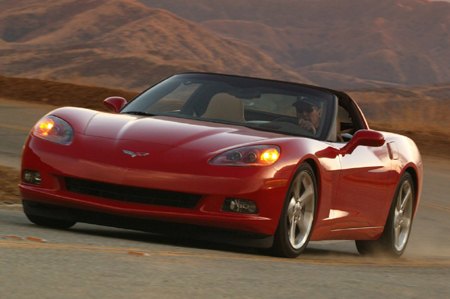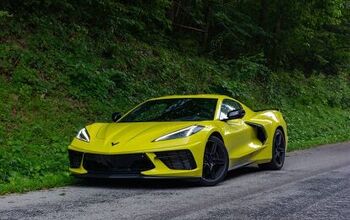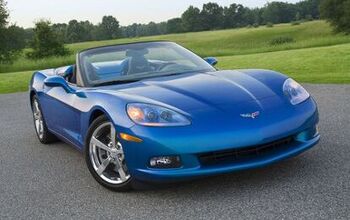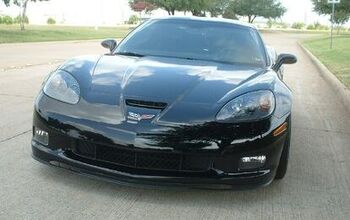Chevrolet Corvette Review
Ever since I can remember, the Chevrolet Corvette has been the fat Elvis of sports cars. Every few years, someone would try to convince me that “America’s sports car” had received the engineering upgrades it needed to restore faded glory. But no. The latest ‘Vette was always a dynamic disaster: a feeble chassis married to lackluster brakes and an incompetent suspension, with more than enough horsepower to make it swap ends with frightening ease. Oh, and the car’s interior remained the only place capable of making a Motel 6 bedroom seem luxurious.
When the latest generation Corvette convertible hoved into view, my expectations were lower than its pavement-scuffing front fascia. Within a week I went from outright hostility to perplexed suspicion, to grudging admiration, to total addiction. The new Corvette still provides plenty of grist for a critic’s mill, but it is, finally, a car an enthusiast can grab by the scruff of its neck, thrash to an inch of its redline, throw into a corner and live to tell the tale.
And oh, what tales! Of vicious corners conquered at heroic speeds, to the sound of ripping rubber and Odin’s induction hammer. Of careening down open highways, posting an ascending stream of triple digit numbers on an ethereal display, knowing there are two more gears left in the V8’s quiver. Of leaping trains of stupefied traffic in a single bound, downing that heady cocktail of schadenfreude and temporal freedom that comes from leaving fellow road users for dead.
Of course, there’s nothing particularly sophisticated about Chevy’s supercar soufflé: light weight, low center of gravity, loads of power, epic torque and sticky tires. By the same token, Lenox Lewis’ right hook isn’t the most elegant of punches, but it gets the job done. That said, the credit for the ‘Vette’s transformation from gold chain goliath to serious sports car goes to its controllable chassis and indefatigable brakes.
Whereas previous ‘Vettes felt as skittish as a new born foal, the new, smaller C6 is planted and predictable all the way to the limits of adhesion– and beyond! Whereas previous ‘Vettes had a Harley Davidson’s ability to make you think ‘OK, I’d really like to stop now’, the C6 ceases forward motion with all the finality of a period hammered into the end of a declarative sentence. [NB: The test car included the nominally optional Z51 Performance Package.]
The Corvette’s inability to maintain lateral stability over broken pavement is its Achilles heel. Blast the ‘Vette over a stretch of rippled concrete and the machine dry-quaplanes. For an infinite instant, the Corvette’s helm has no effect whatsoever on the car’s direction. Bottom line: a Porsche pilot can attack a road without undue concern about surface quality, while a sensible ‘Vette driver must constantly monitor the situation, back-off when necessary, or die. With that limitation in mind, caning a C6 Corvette is as much fun as you can have with your clothes on– unless you drive naked.
In every other way, the Corvette is the same old piece of kit. Aesthetically, it’s so not a classic it hurts. Faired-in projector headlights, descending front and rear strakes (that make the car look like it’s sagging in the middle), blobular side mirrors, circular taillights– the Devil’s in the details. The previous Corvette’s Rubenesque body displayed a purity of form and simplicity of line that a Ferraristi could [grudgingly] admire. The new shape is more Viper than voluptuous.
Once again, still, the ‘Vette’s interior is cheaper (and nastier) than malt liquor. The cabin is suffused with model airplane plastic– from the world’s flimsiest ashtray to the most unconvincing metal-effect binnacle ever created by hand of man. The wet-look plastic cowls behind the seats is existentially horrendous; why do bad things happen to good polymers? The ‘Vette’s seats lack sufficient lateral bolstering for maximum G’s, or thigh support for long distance love. And the steering wheel looks like a decapitated dwarf.
Chevy’s usual defense is to reprise the Bang for The Buck theme song and hope the audience hums the tune as it leaves the showroom, forgiving and forgetting the Corvette’s ergonomic and aesthetic failings. The truth is that the C6’s action sequences are compelling enough for endless repeats, while the V8’s soundtrack (above 4000rpm) haunts the enthusiast’s dreams. Sure, but is the new Corvette better than a 911 or, for that matter, a Boxster S? That depends on whether you prefer the perfectly polished energy of the young, RCA Elvis; or the raw power of Mr. ’68 Comeback Special. Either way, open-minded pistonheads can rejoice: fat Elvis has left the building.
More by Robert Farago
Latest Car Reviews
Read moreLatest Product Reviews
Read moreRecent Comments
- UnoGeeks Great information. Unogeeks is the top SAP ABAP Training Institute, which provides the best SAP ABAP Training
- ToolGuy This thing here is interesting.For example, I can select "Historical" and "EV stock" and "Cars" and "USA" and see how many BEVs and PHEVs were on U.S. roads from 2010 to 2023."EV stock share" is also interesting. Or perhaps you prefer "EV sales share".If you are in the U.S., whatever you do, do not select "World" in the 'Region' dropdown. It might blow your small insular mind. 😉
- ToolGuy This podcast was pretty interesting. I listened to it this morning, and now I am commenting. Listened to the podcast, now commenting on the podcast. See how this works? LOL.
- VoGhost If you want this to succeed, enlarge the battery and make the vehicle in Spartanburg so you buyers get the $7,500 discount.
- Jeff Look at the the 65 and 66 Pontiacs some of the most beautiful and well made Pontiacs. 66 Olds Toronado and 67 Cadillac Eldorado were beautiful as well. Mercury had some really nice looking cars during the 60s as well. The 69 thru 72 Grand Prix were nice along with the first generation of Monte Carlo 70 thru 72. Midsize GM cars were nice as well.The 69s were still good but the cheapening started in 68. Even the 70s GMs were good but fit and finish took a dive especially the interiors with more plastics and more shared interiors.






































Comments
Join the conversation